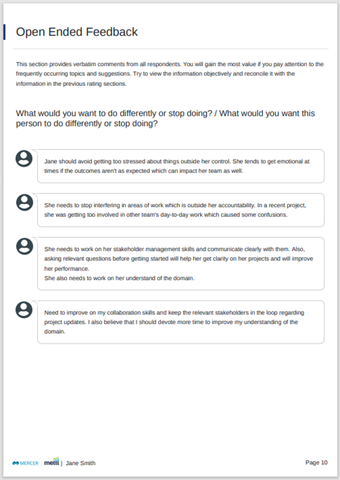Mercer Mettl 360View: Reports explained
Cover Page
The cover page of the report shows the survey name and participant's name for whom the report has been generated.
Table of Contents
This gives a brief summary of all the sections in the report. You can jump to any section by just clicking on that section’s name.
Introduction
Introduction page gives an overview of the survey and the complete process. It shares some guidelines in terms of how the report should be approached, the purpose of the complete 360feedback exercise etc. This is completely customizable.
Respondent Summary
This gives a summary on the respondents that were nominated for the survey from various relationships. This page is optional.
Competency Summary
This is the main section of the report that gives an analysis of ratings for each competency. You can read what the competency signifies and see the average score for the competency on a relationship level. You can also see the highest and the lowest ratings given by each relationship for a better analysis of the ratings. Benchmarks, if set for the reports, will also be visible here for each competency.
Competency Summary (Spider Chart)
This shows a spread of the ratings received from each relationship for the various competencies. This helps in doing a comparative analysis between the competency ratings given by the various respondents. Analysis can be done either based on a competency or a relationship. This page is optional.
Optional Sections
To get a deeper
understanding of these ratings, we have yet another optional section in the
report that highlights the difference in perception in ratings between Self and
Other relationships, if any. Based on Johari Window, the ratings given to Self
and the rating given by All Others are compared for each statement and some
meaningful insights as derived such as:
Strengths
These are the statements on which both the person rating themselves and Feedback Providers from other relationships agree upon to be strong pursuits of the Feedback Seeker.Areas of ImprovementThese are the statements on which both the person rating themselves and Feedback Providers from other relationships agree upon to be areas on which the Feedback Seeker needs to work upon.Hidden Strengths
These are the statements on which the person rating themselves tend to score themselves lesser than the other Feedback Providers. These are the areas the Feedback Seeker is perceived to be good at by the other Feedback Providers.Blind Spots
These are the statements on which the person rating themselves tend to score themselves higher than the other Feedback Providers. These are the areas the Feedback Seeker believes that they are good at but unfortunately this is not agreed upon by the other Feedback Providers.
Open-Ended FeedbackIn this section, you can read about the verbatim of the feedbacks received by the Feedback Seekers for open-ended questions is shown in the report. We take care that the anonymity of the feedback providers is maintained throughout the report while showing these comments.
Detailed Feedback
In this optional section, a detailed feedback analysis for each statement in the survey is shown. Here, relationship-wise feedback for each statement lying under a competency is displayed.Development Plan
Lastly, based on the scores of a person, their report may consist of a development plan that best suits them based on their performance in various competencies. Accordingly, competency scores lying below a threshold qualify to be considered for a development plan need. Development activities such as trainings, reading materials, individual sessions with their reporting managers etc. can be suggested to Feedback Seekers to focus on their growth.